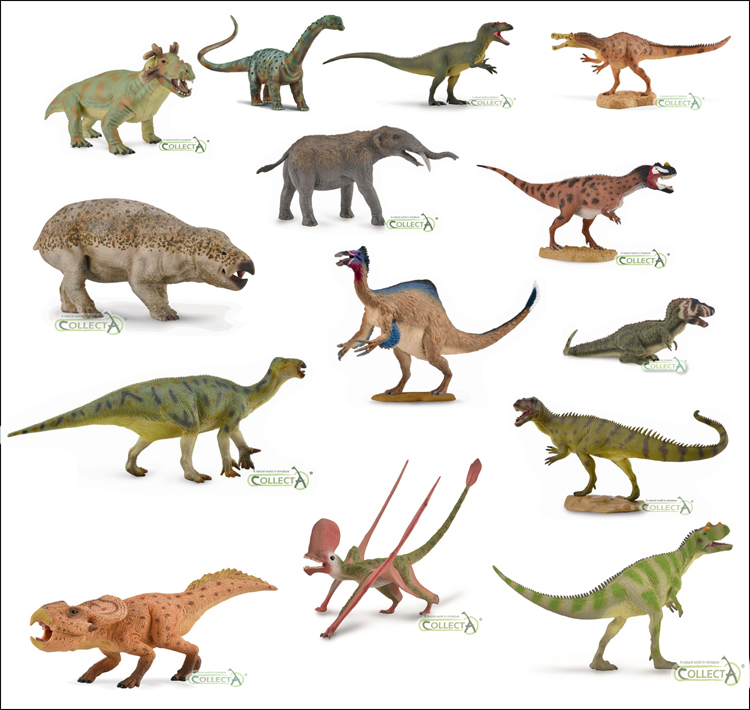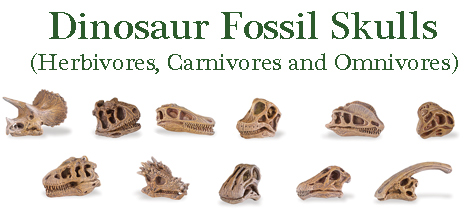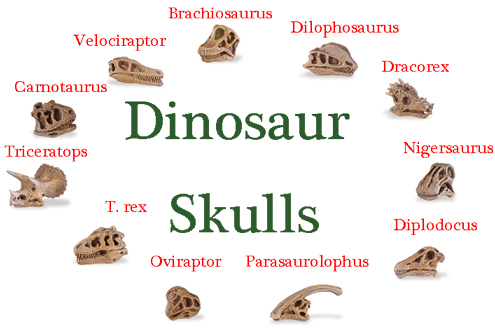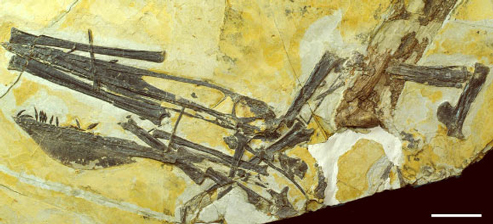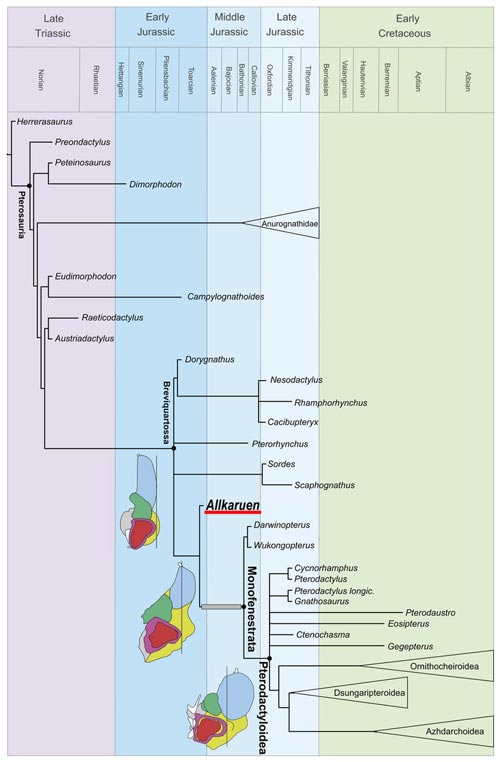Allkaruen koi – Braincase and All
A team of international scientists including Leicester University’s David Unwin and Oliver Rauhut (conservator at the Bavarian Collection for Palaeontology and Geology), have announced the discovery of a new species of long-tailed pterosaur from Patagonia (Argentina).
A Long-tailed Pterosaur
Writing in the academic journal “PeerJ”, the researchers were able to infer new information about how pterosaurs adapted to an aerial lifestyle thanks to the three-dimensional preservation of the cranial material. From this skull material, the team were able to gain fresh insights into the braincase and the structure of the inner ear. The new species of pterosaur will help palaeontologists to better understand differences between the primitive, primarily long-tailed “rhamphorhynchoids”, also known as non-pterodactyloids and the more derived and later, short-tailed pterodactyloids.
An Illustration of the New Pterosaur (Allkaruen koi)

An illustration of the newly described Jurassic pterosaur from Argentina called Allkaruen.
Picture credit: Gabriel Lio
For models and replicas of pterosaurs and other creatures: Wild Safari Prehistoric World Models.
The Evolution and Radiation of the Pterosauria
The fossilised remains of this new pterosaur come from the Cañadón Asfalto Formation, exposed in the northern/central Chubut Province of southern Argentina. The fossil material came from a single bedding plane formed from freshwater limestone deposits, indicating that there was a large, inland body of water present. The fossils were scattered although elements such as the mandible preserved a degree of articulation. The rocks of the Cañadón Asfalto Formation had been thought to be about 162 million years of age (Callovian to Oxfordian faunal stages – latest Middle to earliest Late Jurassic), however recent radiometric and biostratigraphical analysis suggests that these rocks might be much older.
Research published in 2013 (Cúneo et al), indicates an age range for this formation of between 183 and 165 million years (Toarcian to Bathonian faunal stages).
The genus name comes from the local Tehuelche dialect word “all” for “brain” and “karuen” which means “ancient”, in recognition of the superb three-dimensional preservation state of the fossil skull. The species name means “lake” in the Tehuelche language, reflecting the fact that the fossils were found in lacustrine deposits,
Fossils and Line Drawings of the Allkaruen koi Material
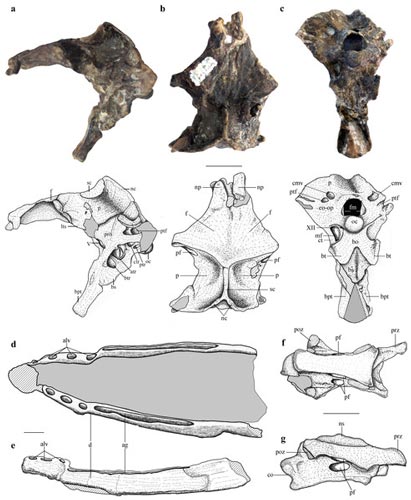
Fossils of the braincase, line drawings of the braincase along with drawings of the mandible and vertebrae.
Picture credit: PeerJ
Two Main Types of Pterosaur
Pterosaurs have remarkable skeletal adaptations for life in the air and they were the first vertebrates to achieve powered flight. Two major body plans have traditionally been recognised, rhamphorhynchoids (non-pterodactyloids) and the pterodactyloids. These two types of flying reptile differ considerably in their general anatomy and also they exhibit very different head postures and neuroanatomy (nervous systems and the study of the brain). Computerised tomography was employed to scan the uncrushed braincase that enabled the scientists to infer more information regarding the shape of the brain and the inner ear.
This study has provided new information on the origins of the highly derived neuroanatomy of pterodactyloids, as, until this new fossil discovery, only a few three-dimensionally preserved braincases of flying reptiles were known and these demonstrated a large morphological gap between the specimens.
The braincase of Allkaruen has helped fill in a portion of that gap to give scientists a better understanding of how the flying abilities of these reptiles evolved.
Dr Diego Pol (CONICET, Museo Paleontológico Egidio Feruglio, Trelew, Chubut, Argentina) and corresponding author for the published paper stated:
“Allkaruen shows an intermediate state in the brain evolution of pterosaurs and their adaptations to the aerial environment. As a result, this research makes an important contribution to the understanding of the evolution of all of pterosaurs.”
A Phylogenetic Analysis
A phylogenetic analysis was undertaken and Allkaruen is nested between monofenestratan breviquartossans (Rhamphorhynchidae) and derived pterodactyloids. Given the age of the fossil and its phylogenetic affinities to Rhamphorhynchus and the pterosaur known as Darwinopterus it has been suggested that this flying reptile had a long tail with a diamond-shaped rudder on the end of it. Analysis of the cranium indicates that Allkaruen had two parallel crests on the top of its skull and it appeared to have teeth restricted to the middle and anterior (front) part of its jaws. Although the exact diet of this pterosaur is not known, given the context of the fossil material and the shape of the teeth, Allkaruen most likely fed on fish.
To read an article on the transitional fossil Darwinopterus: Darwinopterus – A Transitional Pterosaur.
Dr Oliver Rauhut has had a busy couple of weeks, he was also one of the principal authors of the scientific paper on the Early Jurassic meglosaurid Wiehenvenator. To read about the “Monster of Minden”: Wiehenovenator – The “Monster of Minden”.
Everything Dinosaur is based in the UK. We produce helpful and informative blog posts including articles about fossil finds.
Visit the Everything Dinosaur website: Everything Dinosaur.


